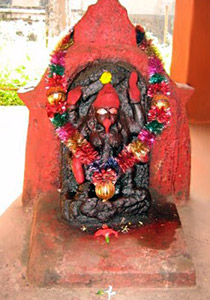As the historical records depict, Kalahandi is a significant historical district. Hence the tourism of the district develops around the historical significance and the interesting centers surrounding the district. The incomplete ruins of the Amathguda fort, situated on the right bank of the river Tel are an important center in the tourism industry of Kalahandi. The strategic importance about the fort lies in the antiquity. The ruined bridge over the river Tel adds splendor to the charming freshness of the Amathguda fort.
The picturesque Ampani hills presenting a panoramic view of nature shares an important place in the tourism industry of Kalahandi. The frolicking valley locally known as "Haladigundi" in Ampani hill range exhibits some peculiar features due to the reflected rays on the sun, which enticed the tourists to its center. Bounty of spotted dear is an added charisma to the pictorial Ampani hills.
Situated on the confluence of the river Tel and Uttei, two tributaries of the river Mahanadi Belkhandi draws prominence in the tourism industry of Kalahandi as an important center of religious activities. The place gains prominence in the tourism industry because of the archaeological importance. Moreover the ruins of the temples reflect the art and sculpture of the 12th Century monuments. The tourism of Kalahandi district has a lot to offer for the lover of the ancient culture. Among the sculptures unearthed images of Sapta Matruka (Seven Mother Goddesses) and Uma Maheswar and the ruins of Belkhandi, preserved in a small museum adjacent to the temple premises deserves special worth as a place of tourist interest.
The Gudahandi hills draw importance as an important center because of the ancient caves bearing pictographic paintings of remote antiquity around the hill.
 Junagarh is historically important as a tourist center because it was the ancient capital of Kalahandi district. It has a well-built fort with a fortified area and has a number of temples, where the past history of the temples is engraved in Oriya inscriptions. In the tourism industry of Kalahandi this place has a special significance because of the sculptural evidence of the "Sati-Rite" which was prevalent in medieval India and was stopped during the British Rule by Lord William Bentink. The sculptures of Sati Pillars constitute as the interesting site for the tourists.
Junagarh is historically important as a tourist center because it was the ancient capital of Kalahandi district. It has a well-built fort with a fortified area and has a number of temples, where the past history of the temples is engraved in Oriya inscriptions. In the tourism industry of Kalahandi this place has a special significance because of the sculptural evidence of the "Sati-Rite" which was prevalent in medieval India and was stopped during the British Rule by Lord William Bentink. The sculptures of Sati Pillars constitute as the interesting site for the tourists.
The "khandual" waterfall at the Karlapat village at the top of a hill is the home of the female deity called "Khandua" and is regarded as a sanctified religious site in the tourism of Kalahandi.
Phurlijharan is a perennial waterfall about 30 Ft in height and has a special charm of its own, for which it is one of the chief center in the tourism industry of Kalahandi. Rabandarh, a place of charming beauty and freshness casting a scenic view is a significant center in the tourism industry of Kalahandi. The key interest about the place is some delightful contrasts of scenery, in mountains and over looking dales and the absolute tranquility it offers.
The tourism industry of Kalahandi witness a thriving prosperity owing to the concentration of variety of significant places having exquisite beauty with historical and religious significance.



















